HTC One mini 2 Review
by Anand Lal Shimpi & Joshua Ho on May 26, 2014 3:00 AM EST- Posted in
- Smartphones
- HTC
- Mobile
- One mini 2
Software
Keeping things in line with the One (M8), the One mini 2 also runs HTC’s Sense 6 UI on top of Android 4.4.2. Surprisingly, in this regard the experience ends up being generally solid, although it’s definitely slower at times than the One (M8). This ultimately boils down to the SoC, and while the quad core Cortex A7 is more than enough to run the main UI smoothly, things like rendering intensive webpages take longer and in general there’s just more waiting time going on in the UI that reduces responsiveness in the OS, something that isn't felt in a phone like the Moto G or phones with lighter skins. Overall though, Sense 6 continues to be good, although there are some changes that have the potential to annoy the user. These are mostly in the camera UI, and while it’s arguably easier to use now, the loss of simple things such as the dual shutter is disappointing, and the strangely artificial divide between scene modes and camera modes can be irritating as well.
Outside of these small regressions though, Sense 6 remains an actual selling point for the phone, rather than against it. The UI is now completely lacking gradients, and fits in visually with most Holo applications, although HTC deviates from the standard Holo blue and grey in favor of other colors, depending upon the theme. Very few applications are duplicates of Google applications. Even the ones that are duplicates of Google applications are ultimately meant for a different purpose, such as the email application for Exchange or other email services outside of Gmail. However, as always, opinions on OEM UIs will always be divisive, and ultimately a personal decision. For more information on the Sense 6 UI, I would reference the HTC One (M8) review.
Ultimately, the bigger issue with software experience is what has been left out. The noticeable lack of sensors, presumably to lower costs, means most of the motion launch gestures have disappeared, and the pedometer is gone as well. The power saver mode interestingly does not seem to effect the CPU governor at all, as max frequency stays capped at 1.2 GHz and the difference between the two means when running a benchmark is too close to point to a change in governor. Extreme power saver mode also doesn’t seem to change the governor either, but this would make sense based upon the low power consumption of the Cortex A7s.
SoC Architecture
The original HTC One mini used a Snapdragon 400 SoC, Qualcomm's MSM8930 to be exact. The new One mini 2 also uses a Snapdragon 400, but it's a different SoC: the MSM8926. I've highlighted the differences in the table below:
| HTC One mini vs One mini 2 | ||||||
| HTC One mini | HTC One mini 2 | |||||
| SoC (Misleading Marketing Name) | Snapdragon 400 | Snapdragon 400 | ||||
| Qualcomm Model Number | MSM8930 | MSM8926 | ||||
| Manufacturing Process | 28nm LP | 28nm LP | ||||
| CPU | 2 x Krait 200 @ 1.4GHz | 4 x ARM Cortex A7 @ 1.2GHz | ||||
| GPU | Qualcomm Adreno 305 | Qualcomm Adreno 305 | ||||
| Modem | MDM9x15 IP block (Category 3 LTE) | MDM9x25 IP block (Category 4 LTE) | ||||
The old SoC featured two of Qualcomm's own Krait 200 cores running at up to 1.4GHz, while the new chip has four ARM Cortex A7 cores running at up to 1.2GHz. I've been spending a lot of time looking at SPECint performance of mobile CPU cores and I think I have a good idea of how Krait 200 stacks up to ARM's Cortex A7. Krait 200 delivers lower IPC in SPECint than ARM's Cortex A7. The difference is small (~9%) but at the same frequency, a Cortex A7 should be faster than a Krait 200. In the case of the One mini vs. One mini 2, the Krait 200 version has a 16% higher max frequency. Whether the new mini is faster or slower than its predecessor depends on just how high of a frequency the old mini is running at. Assuming there's no thermal throttling at play, the original mini may hold a slight performance advantage (~4 - 5%). I suspect ARM's Cortex A7 draws less power however, so we may see situations where the gap narrows. Of course the new SoC has twice as many CPU cores, so in heavy multitasking scenarios or running any applications that stress more than two cores the new mini will see an advantage. Unfortunately this is the tradeoff that many SoC vendors have been forced to make. Rather than pushing for two cores with substantially higher IPC, we have four cores with a mild increase in IPC from one generation to the next.
GPU performance should be comparable between the two devices.
As the Moto G showed us, ARM's Cortex A7 is fast enough to run Android and most apps - particularly when backed by Qualcomm's Adreno 305 GPU. Generally speaking, the One mini 2 is fine from a performance perspective. The one difference between the mini 2 and the Moto G however is Sense 6 feels a bit too heavy for the CPU setup. There's a reduction in responsiveness on the mini 2 that the Moto G avoids by using a much lighter weight UI (thanks to it being mostly stock Android). Had HTC waited for the Snapdragon 410 my guess is it would've been fine, but as it stands I think I'd prefer a hypothetical Google Play Edition of the One mini 2.
CPU Performance
As expected, there original One mini manages to pull ahead of the One mini 2 in all of our CPU tests. Although ARM's Cortex A7 is higher IPC than Krait 200, the latter runs at a higher frequency which gives it the slight performance edge. It's only in situations where more than two cores are in use where the new MSM8926 based SoC will do better than its predecessor.
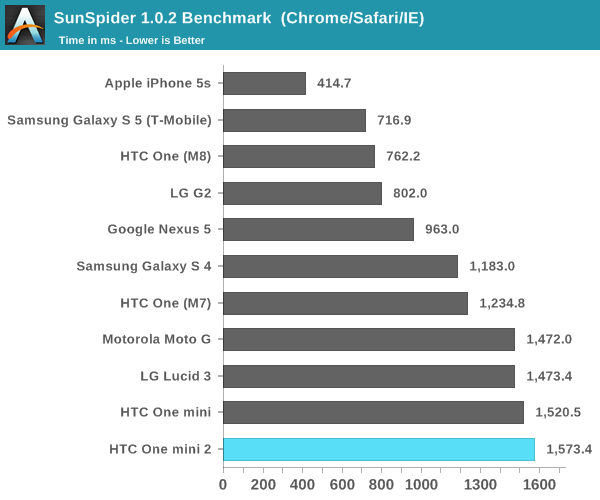
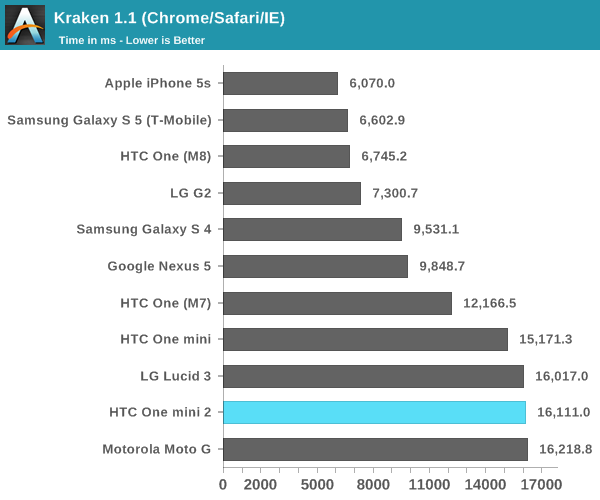

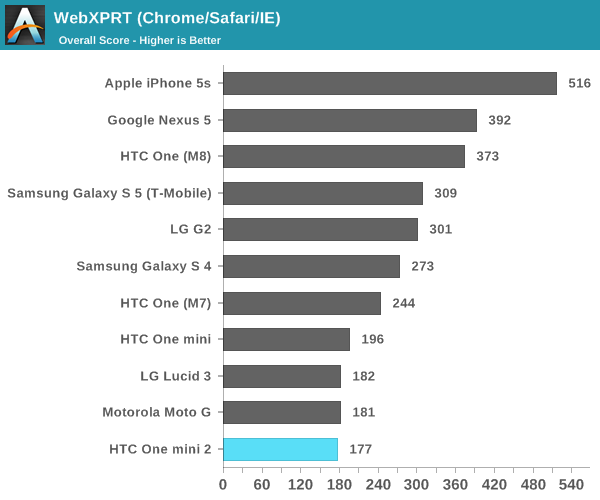
Although BaseMark OS II indicates a large performance gap between the One mini and One mini 2, the bulk of the difference here is due to the web test. The web test leverages any webview differences in the software builds between the devices, which gives the One mini 2 a substantial advantage here.

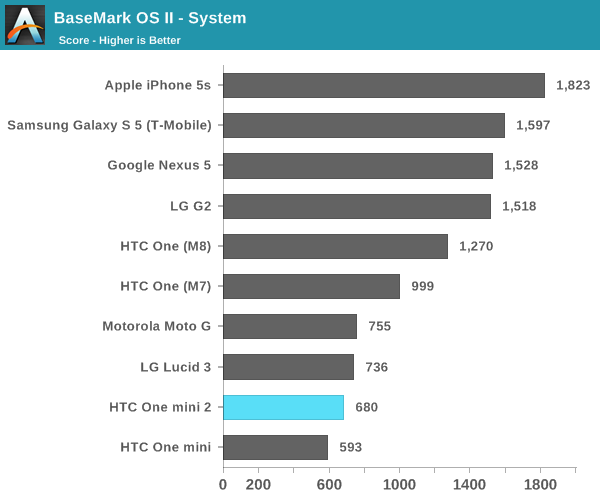

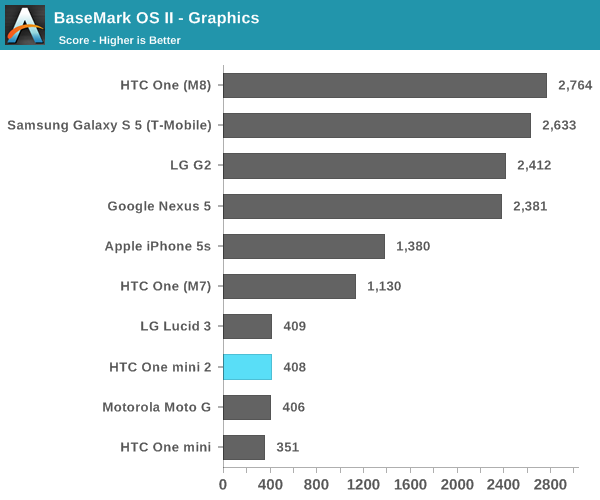

GPU Performance
At a high level, GPU performance is effectively unchanged between the One mini and One mini 2. The tests below will show some differences, but they're simple to understand. 3DMark's Physics test is well threaded and takes advantage of all four cores in the One mini 2, the result is a 54% increase in performance over the One mini.
The GFXBench T-Rex HD offscreen test shows the old and new mini devices performing fairly closely to one another.
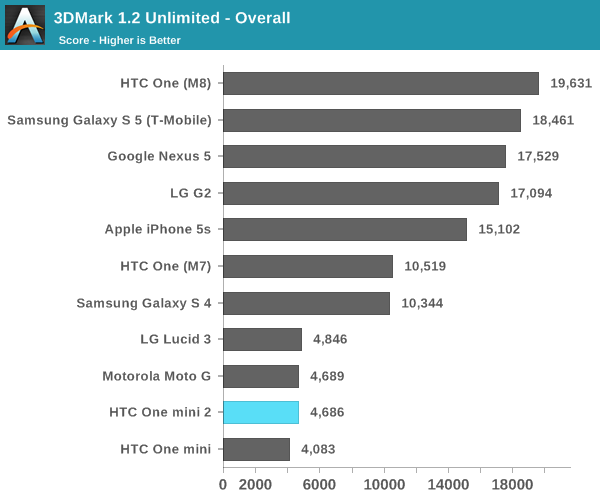
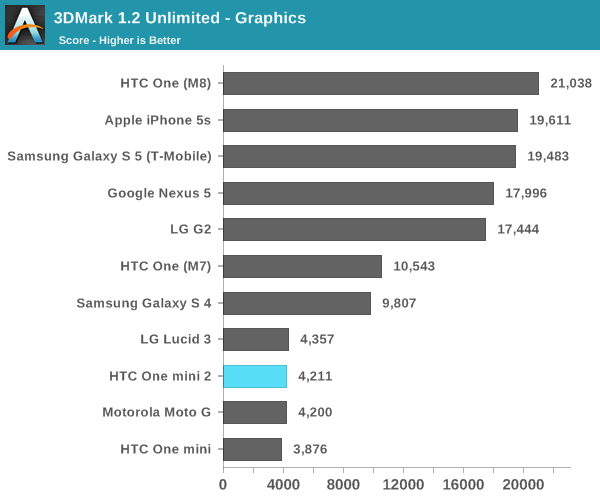
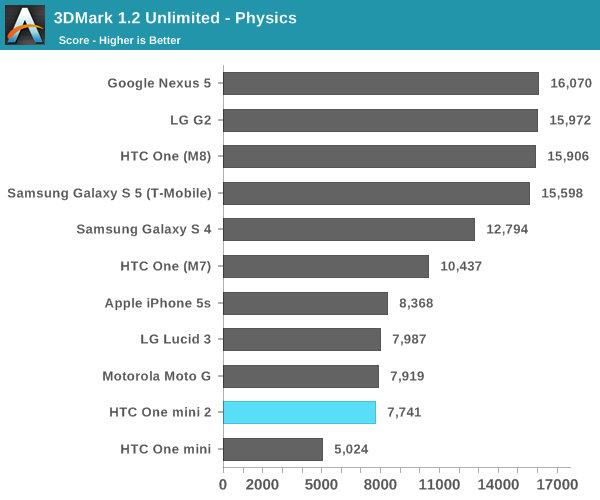
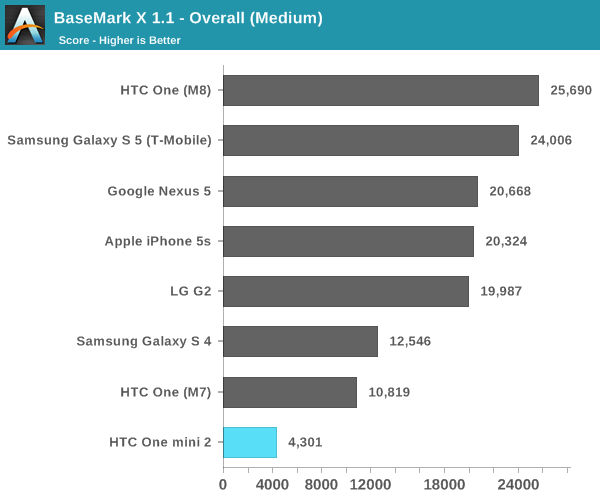
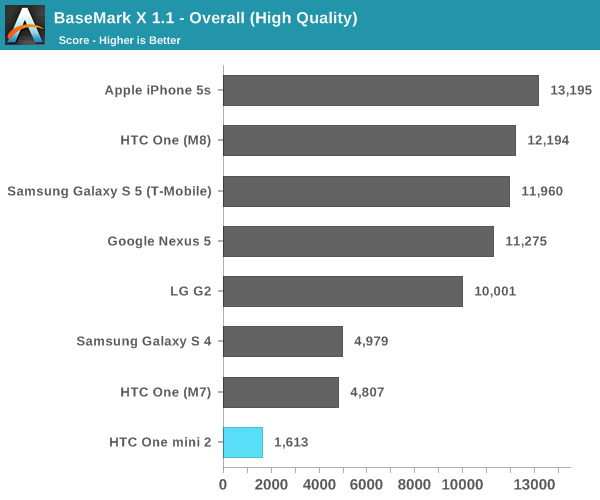

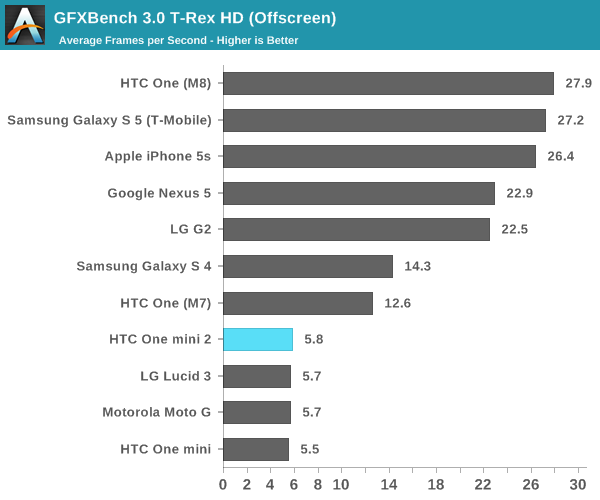
NAND Performance
The One mini 2 features 16GB of internal NAND as well as a microSD card slot for external expansion. The internal NAND definitely lacks in random read/write performance, but has absolutely modern sequential IO performance. The random read speed seems reasonable, but random write speed is a bit lower than I'd like. Sequential read performance is pretty solid - if you can keep the internal NAND relatively clean (leave ~25% free) you should have a fairly responsive device from an IO perspective.
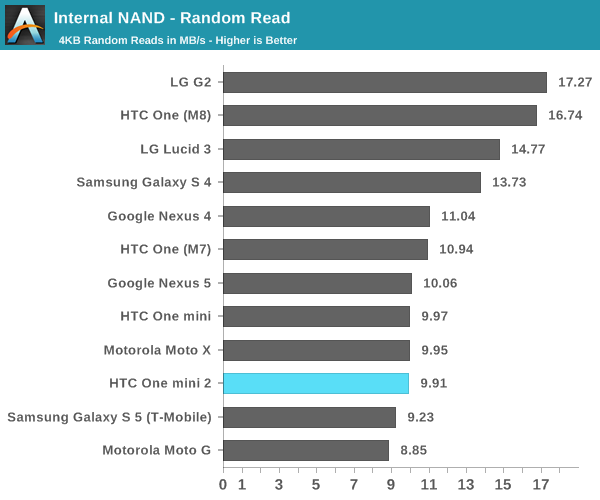

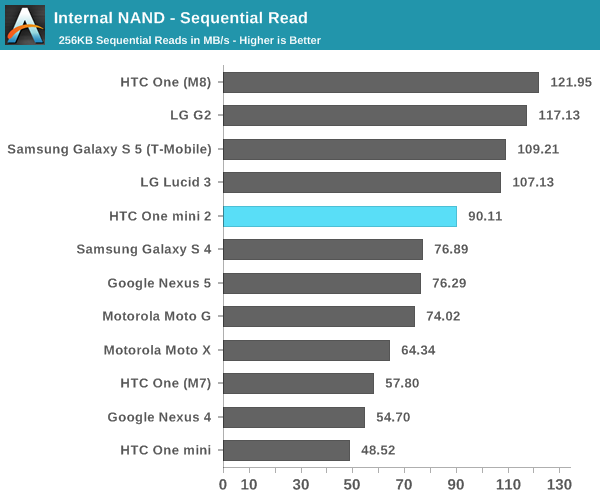
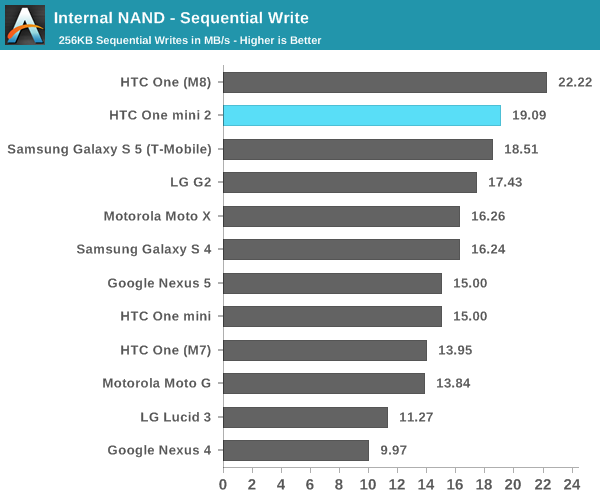










76 Comments
View All Comments
devione - Monday, May 26, 2014 - link
Why, oh why, can't more manufacturers follow the Sony Z1 Compact route..Johnmcl7 - Monday, May 26, 2014 - link
I'd be interested to see the sales figures for the Z1 Compact in Europe where the phone is widely available to see if Sony's strategy of producing a flagship phone with a smaller screen has worked out for them. On paper the phone looks pretty much exactly what everyone has been wanting for a while in Android with a top end SoC, camera, micro SD, decent screen even weather sealing and without much compromise either as the price is reasonable as is the batterylife. It makes a complete mockery of the HTC Mini 2 as they both appear to be a similar price despite the Sony being a much more capable device.Yet I've not seen anyone with a Z1 Compact despite plenty of other Android phones and I've hardly seen any second hand for sale (I want a cheap one for going out cycling) whereas there's quite a few S5's around even though it's only recently released. I realise none of that's statistically relevant hence I'd like to see the sales data.
I do think Sony were too slow releasing the Z1 Compact, I think if they'd released it around two years after the Galaxy S2 they'd have been in the perfect position to catch those who wanted a similar sized phone with top end specs. I knew quite a few people who had S2's and didn't want an S4 due to the increase in size however as there wasn't anything suitable in a smaller form factor with Android they went with the S4 and find the size is fine.
A few friends and family have 'mini' phones particularly the S3 Mini and S4 Mini but they didn't just want a smaller phone they also wanted a cheap phone so wouldn't have considered a Z1 Compact if available.
Laxaa - Monday, May 26, 2014 - link
My brother just bought the Z1 Compact, and it's an impressive piece of kit. I only wish it had OIS and a better camera app(like Nokia Camera on the Lumias)Death666Angel - Monday, May 26, 2014 - link
From the article: "HTC then proceeded to launch the One mini, a phone that was the size that everyone had been asking for"From Johnmcl7: " On paper the phone looks pretty much exactly what everyone has been wanting for a while in Android".
Really? Everyone wanted a phone like that? I didn't. I was fine with 4.3" in my SGS2 when the iPhone established the 3.x" form factor. I liked my 4.65" Galaxy Nexus when that was becoming the norm and I like the 5.2" LG G2 which is doesn't feel much larger than the GN. So count me out of that "everyone" group, please. Not everyone is looking for smaller flag ship phones, just like not everyone is looking for microSD card slots, replaceable batteries or phones made out of aluminum. Some are, others aren't. I'm someone who is fine with lugging around his Nexus 7 when I'm wearing a jacket. The 5.2" G2 fits perfectly fine in all my trousers and I have never thought "bly me, that size is really bothering me".
Johnmcl7 - Monday, May 26, 2014 - link
OK, wrong turn of speech - my own phone is a Sony Z Ultra (6.4in screen) so I certainly appreciate the benefits of a larger screen.fokka - Wednesday, May 28, 2014 - link
i'm really happy for you and you're right, not "everyone" wants all those things you list. the problem is that for people who are happy with 5"+ phones there already are many options - the whole flagship-segment caters to them.but for those who want all the power in a slightly smaller form factor there is exactly one viable offering - not much considered the dozens/hundreds of models on the market. and even this lonely smartphone will be "obsolete" in a matter of months, considering the specs of current and coming flagships.
in a market like this, i think it's clear and also warranted, that people are complaining. but even if we aren't "everybody", it's still important that we voice our opinions. sorry if you felt collateralized ;)
sfuzzz - Monday, May 26, 2014 - link
I feel exactly the same. Z1 Compact is a great phone (with some flaws like other) and the right size for everyday life, you don't have to carry a bag or a jacket only for your phone. I own a Nexus 5, coming from a Xperia U (perfect size for me) and this summer will see if i go mad feeling it in my pockets all day. As for the sales (of Z1 compact) It's difficult to tell the real figures, here in Italy is available for 450/420 euros or less, but anything that is not Samsung or iPhone is a "niche" phone. I own a N5, my sister owns a Moto G, and we are considered some kind of "geeks" only for that :)Gich - Monday, May 26, 2014 - link
4xCortex-A7 can't keep up with 2xKrait 200 on benchmarks that do stress all core... and it should be worst on "normal" apps.Isn't this... very bad?
Gich - Monday, May 26, 2014 - link
Also "it’s not much of an improvement"? I feel is more of a step back.tipoo - Monday, May 26, 2014 - link
Yeah, I'd take dual krait over any number of A7 cores any day.